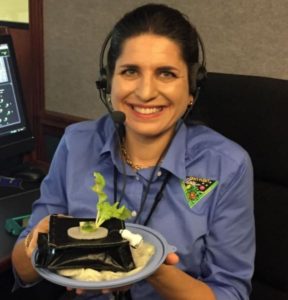2025年には日本人宇宙飛行士が月に降り立つ日がやってくるかもしれません。
そんなワクワクする気持ちで次のBBC記事を読むとさらに夢が広がります。
宇宙で開発された植物や食物を食べる日がいつかきっとやってくると思います。
Introduction
You are used to having your vegetables coming from agricultural land, but how about space? Listen to the programme to find out how growing plants in space might help develop crops which are more productive and more resistant to climate change here on Earth.
はじめに
野菜は農地で採れたものを食べるのが当たり前になっていますが、宇宙で採れたものだったらどうでしょう。番組を聴いて発見してください。宇宙で植物を育てることが、地球上で生産性を高めた、気候変動に強い作物を開発するのに役立つかもしれません。
Last November Nasa launched a very unusual home delivery service – a rocket carrying four tonnes of supplies to the ISS – the International Space Station.
NASAは昨年11月、非常に珍しい宅配便を打ち上げました。ISS、国際宇宙ステーションに4トンの物資をロケットで届けたのです。
Among the scientific equipment were twelve bottles of red wine from the famous Bordeaux region of France.
科学機器と一緒に積み込まれたのは、フランスの有名なボルドー産の赤ワイン12本でした。
The astronauts might have wanted a glass of wine with dinner, but the real purpose of the bottles was to explore the possibility of producing food and drink in space – not for astronauts but for people back on Earth.
宇宙飛行士は夕食でワインを飲みたかったかもしれませんが、このボトルを届けた本当の目的は、宇宙で飲食物を生産する可能性を探ることでした。宇宙飛行士のためではなく、地球上の人々のためだったのです。
In today’s programme we’ll be finding out how growing plants in space can develop crops which are more productive and more resistant to climate change here on Earth.
今日の番組では、宇宙で植物を育てることで、地球上で生産性を高めた、気候変動に強い作物を開発する方法を紹介します。
And we’ll hear how plants can grow in environments with little or no natural light. But first, today’s quiz question: what was the first food grown in space? Was it:
a) potatoes?
b) lettuce?, or
c) tomatoes?
それとともに、自然光がほとんどない環境でも植物が育つ方法を聴きます。さて、今日のクイズは、宇宙で最初に栽培された食べ物が何かです。次から選んでください。
a) ジャガイモ
b) レタス
C)トマト
We’ll find out the answer later. Now, you might be wondering how it’s possible to grow plants without natural light. British company Vertical Future has been working on this problem by developing indoor farming methods in partnership with Nasa.
答えは後ほど明らかにします。さて、自然光を使わずに植物を育てることができるのか、気になるところかもしれません。英国のバーチカル・フューチャー社は、NASAと提携して室内での栽培方法を開発し、この問題に取り組んでいます。
Here’s their Head of Research, Jen Bromley, explaining the process to BBC World Service programme, The Food Chain.
ここでは、調査部の責任者、ジェン・ブロムリーが、BBCワールドサービスの番組「フードチェーン」で植物育成プロセスについて説明します。
*************************************************************
Jen Bromley
Basically we use LED lighting and we use LED lights that are tuned to a specific wavelength. So, if you image what the rainbow looks like, the reason a plant looks green is because it’s not using all the green light – it actually reflects a lot of that back. So the reason why it looks pink in here is because we’re actually only using red light and blue light to grow the plants, and that essentially tailors the light diet so that the plants look black when you look at them because they’re not reflecting any light – they’re being super-efficient, they’re using up every photon that hits them.
ジェン・ブロムリー
基本的にLED照明を使用し、特定の波長に調整されたLED照明を使用しています。つまり虹がどのように見えるかを想像すると、植物が緑色に見えるのは、緑色の光をすべて使用していないためです。実際には緑色の光の多くを反射しているのです。
だからここがピンクに見える理由は、実際には赤い光と青い光だけを使用している植物を育てているからです。それによって根本的に(植物にとって食事となる)光を調整しています。植物を見ると黒いように見えるのはあらゆる光を反射しないからです。というのは、植物は超効率的で、照射されたすべての光子を吸収しているのです。
*************************************************************
The lack of natural light in space means that plants are grown using LED lights – LED is an abbreviation of ‘light emitting diode’ – an electronic device that lights up when electricity is passed through it.
自然光が不足している空間では、LEDライトを使って植物を育てています。LEDとは「発光ダイオード」の略で、電気を通すと点灯する電子機器です。
On Earth plants look green because they reflect back any light travelling at a certain wavelength – the distance between two waves of light which make things appear to us in the various colours of the rainbow.
地球上の植物が緑色に見えるのは、植物がある波長の光を反射しているからです。波長とは、光の振動の2つの波が進む距離のことで、この波長の違いによって虹に見える様々な色となるのです。
But when scientists control the wavelengths being fed, plants are able to absorb every photon – particle of light energy, making them appear black.
しかし、科学者が供給されている波長をコントロールすると、植物はすべての光子(光エネルギーの粒子)を吸収することができ、そうすると植物が黒く見えるようになります。
Each particle of light that hits the leaves is absorbed and through photosynthesis is converted into plant food. Nasa found that different colour combinations, or light recipes, can change a plant’s shape, size and even flavour.
葉に当たった光の一粒一粒が吸収され、光合成を経て植物の食物に変換されます。NASAは、異なる色の組み合わせや光のレシピによって、植物の形や大きさ、さらには風味までも変えることができることを発見しました。
But the lack of natural light isn’t the biggest obstacle to growing food in space. Here’s Gioia Massa, chief plant scientist at the Kennedy Space Centre in Florida, to explain.
しかし、自然光の不足は、宇宙で食べ物を育てる上での最大の障害ではありません。フロリダにあるケネディ宇宙センターの植物科学主任のジョイア・マッサ氏が説明してくれます。
*************************************************************
Gioia Massa
Microgravity is really challenging but plants are amazing! They can adapt to so many different environments – we call this plasticity because they can turn on or off their genes to really adapt to all sorts of conditions and that’s why you see plants growing in different areas on Earth – the same type of plant may look very different because it’s adapting to the environment in that specific location.
ジョイア・マッサ
微小重力は本当に難しいですが、その一方で植物の素晴らしさには驚かされます。植物は非常に多くの異なる環境に適応ができます。遺伝子をオン、オフしてあらゆる種類の条件に適応できるので、これを「可塑性」と呼んでいます。この適応性があるから、地球上のさまざまな場所で植物が成長しているのを見ることができるのです。たとえば同じ種類の植物なのにひどく違って見えるものがありますが、これは特定の場所の環境に適応しているからなのです。*************************************************************
On Earth, plants use gravity to position themselves – shoots grow up, roots grow down. But this doesn’t apply in space because of microgravity – the weaker pull of gravity making things float and seem weightless.
植物がこのような状況で生き残ることができるのはひとえに、生物の可塑性、つまり生物の構造を変えることで環境の変化に適応し、対処する生物の能力があるからです。
Plants adapt themselves to being in space by manipulating their genes – chemicals and DNA in the cells of plants and animals which control their development and behaviour.
In the low-gravity atmosphere of space, plants become stressed but they adapt genetically.
宇宙の低重力環境では、植物はストレスを受けますが、遺伝的に適応します。
And as a result they’re stronger and more resilient to other, less stressful events when they return home to Earth.
その結果、地球に帰ってきた植物は、他のストレスの少ない出来事に対して、強さが増し、抵抗力が高まったものになりました。
Like those bottles of red wine orbiting Earth as we speak. The effects of microgravity on the wine’s organic composition will be studied and could hopefully offer solutions for growing food in Earth’s changing climate.
ちょうどさっき話した、地球を周回している赤ワインのボトルのようにです。微小重力がワインの有機物組成に与える影響を研究し、うまくいけば、変化する地球の気候の中で食料を栽培するための解決策を提供することができるでしょう。
So, if it wasn’t red grapes, what was the first food grown in space?
それはそうとして、赤ブドウじゃないとして、宇宙で最初に栽培された食べ物はなんだったのでしょう。
In fact it was… b) lettuce – grown over fifteen months on the ISS, then eaten in fifteen minutes in the first ever space salad.
実は… b) レタスが答です。ISSで15ヶ月間かけて育てられたレタスは、史上初の宇宙サラダとして15分で食べられました。
- 投稿タグ
- space



最近のコメント